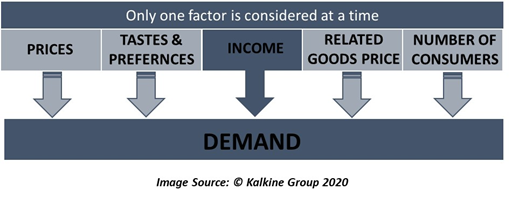What is meant by ceteris paribus?
Ceteris paribus quite literally translates to “all else left equal”. It is a phrase used in economics to analyse the impact of one factor on the variable of interest, by keeping all other factors constant. It is a tool used to single out the effects of one variable without changing other specifications of a model.
The phrase is commonly used while explaining economic cause and effect relationships. Whenever a determinant factor is said to affect a variable, there is an underlying assumption of ceteris paribus.

For instance, there are various determinants of demand like income, price, tastes and preferences, etc. If the effects of income on the demand of a goo d were to be observed, then all other factors would have to be held constant. Therefore, the effect of income would be computed under the assumption of ceteris paribus.
If the other factors are not held constant, then there is a chance that the changes arriving in the variable of interest could be a result of other variables. In this case, without the condition of ceteris paribus, any changes in demand could be observed because of changes in prices, or in the tastes and preferences. Therefore, it becomes hard to distinguish between the impact of one factor from the other.
Ceteris paribus condition helps keep other factors insignificant, by focusing only on one factor at a time.
How did the ceteris paribus condition originate?
Ceteris Paribus is a Latin phrase. Up until the 1950s, it was believed that ceteris paribus condition was exclusively limited to the studies made in the field of social sciences. The earliest usage of the term has been recorded in the field of economics and dates back to the 13th century.
However, outside the domain of economics, the condition of ceteris paribus was controversial. It was mathematician Imre Laktos, who, in 1970, argued that every physical theory requires the usage of the ceteris paribus condition, even if it was given by Newton.
By the end of 1980s, discussions surrounding the validity and usage of ceteris paribus condition gained momentum. There were arguments on the structure of all relationships including scientific and economic and on the viability of special sciences being given the status of an ‘autonomous discipline’.
Therefore, this condition was perceived as a more practical way of perceiving the already existing laws and theories. Economists and mathematicians argued that changes in a variable may be influenced by a variety of factors. Therefore, a theory that centres around the effect of only variable on the other automatically assumes other factors being equal.
Why is the usage of ceteris paribus controversial?
It has long been argued that this condition of ceteris paribus is not testable from a practical standpoint. This means that it is practically impossible to single out one determining factor from another. Most causal relationships expressed in theories and laws function because of a combination of factors. Simply assuming that at a time only one factor is affecting the variable of interest is not achievable.
Economists agree that the assumption of other factors being constant is not very practical. Yet, this condition continues to remain integral to various economic theories developed over time.
It is also argued that ceteris paribus is an easier way of reasoning out inexplicable or unaccounted changes that take place in a model. Consider, for instance, the fact that a decline in prices is predicted to increase demand as given by the Law of Demand. However, when the same is not achieved in the real world, theorists may argue that the condition of ceteris paribus does not hold and there are factors other than prices that are influencing demand.
Although, this fact is true, it takes away the practical applicability of reducing prices as explained in the law of demand. On paper, singling out a determining factor may provide a theory, however, if it can not be applied to the real world then it becomes less credible.
The vagueness in the ceteris paribus principle allows for it to be used as a counterexample for any fallacies seen in the existing laws.
It can be concluded from these points that empirical procedures used in testing out a theory are different from the empirical meaningfulness of the theory. The “all else equal” method of empirical testing makes sense if it understood as a testing procedure and not as a law on its own.
Why is ceteris paribus acceptable in economic theories despite the debates?
Economics is a subject that relies heavily on assumptions, and it is with the help of these assumptions that unquantifiable factors can be classified into numerable forms. Demand and supply curves, utility curves are some examples of the same.
The principles and theories based under the assumption of ceteris paribus can not be discounted as impractical as they have high applicability when it comes to testing policies of the government or any new initiative being adopted into the economy.
The assumption-based models help develop a foundation based on which various decisions are taken in an economy. Therefore, when seen through a macroscopic lens, these assumptions make sense, which is part of the reason why they are still used even in sophisticated models.
Thus, ceteris paribus can be thought of as a methodological tool rather than an empirically achievable condition. While it is integral in developing a theory, it may not be a very practical situation to achieve. However, that does not take away its credibility as it helps simplify complex economic phenomena wherein multiple changes are taking place simultaneously.
 Please wait processing your request...
Please wait processing your request...